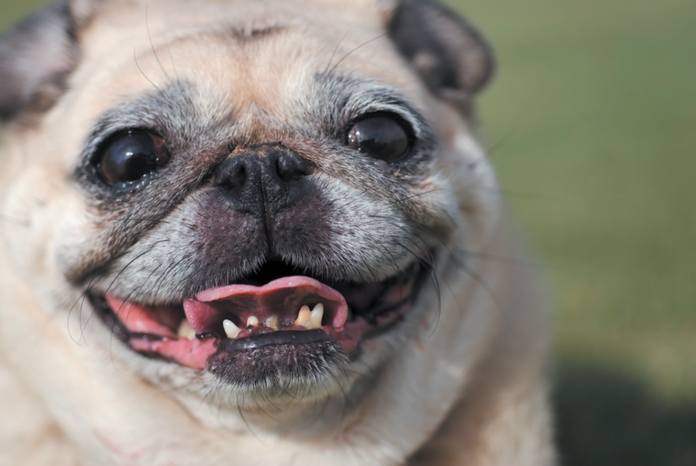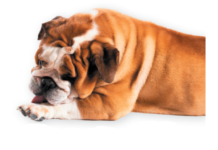Orthodontics in dogs is never done for cosmetic reasons. Nor do dogs get those silver railroad tracks you see on kids. So why do some dogs get braces? And what kind do they get?
The reasons for braces
A dog makes a good candidate for braces if the upper and lower teeth don’t line up properly when she bites. It’s not about chewing. Even toothless dogs can eat their food without difficulty. It’s about a skeletal abnormality. In most cases, the lower jaw, or mandible, is out of whack.
Usually, it’s too short. The condition is called mandibular brachygnathism. “Brachy” comes from the Greek for “short” or “brief,” and “gnathism” come from “gnathos,” which is Greek for “jaw.”
What it means in practical terms is that a dog’s lower canines — the very pointy teeth — hit the hard palate at the roof of her mouth instead of lining up between other teeth whenever she bites. They’re so sharp they can literally cause a hole to form in the palate that connects from the mouth up into the nose. The hole, called an oronasal fistula, can make a dog continually get food in her nose and develop chronic nasal infections.
This is to say nothing of the intense pain that comes with poking sharp teeth into the palate. Consider that dogs, like people, bite down for a variety of reasons throughout the day, not just for eating.
A second bite problem that occurs almost as frequently as mandibular brachygnathism is called mandibular micrognathism. In that situation, the lower jaw is not only shorter than it needs to be but also narrower.
Finally, a dog can have linguoverted canines, or base-narrow canines, meaning the jaw is normal length and width, but the lower canines have grown in too close to the tongue. They’re too central in the mouth instead of out at the edges.
The breeds most prone to having their lower canines act as though they are sharp, piercing swords include German shepherds and standard poodles, but any breed can be affected.
The best time of a dog’s life for braces
It’s best to put braces on a dog who needs them when the adult teeth have come in. That’s usually around 6 months of age. The bone is more pliable then and therefore allows the teeth to move a little faster in the direction you want than if you wait until the dog is closer to 1 year old. With a 6-month-old dog, the braces may have to stay on for 2 months. With, say, a 10-month-old dog, they will need to stay on more on the order of 4 months.
Owners generally know when they adopt a puppy that something is wrong. You can see that the jaws don’t line up, so getting to the veterinarian for help isn’t a problem.
The apparatus itself
The orthodontic appliance put into a pup’s mouth is called an incline bite plane. Built out of the same white dental composite used to make temporary crowns for people, it looks like a little ramp that goes on the upper teeth between the canines and the incisors. That’s just where the lower canines reach on their way to the upper palate. But the ramp tips the lower canines out so they can never get high enough to drill into the palate. It actually works its magic each time the dog bites down, deflecting the teeth outward and forward and thereby nudging them into a better position.
Why not just pull the problem teeth?
You might ask, if a dog doesn’t need teeth to chew, why not just pull out the lower canines? The reason is that orthodontia is easier than pulling out the teeth. The roots of the lower canines are about double the length of their crowns (the white part that you can see). Removing them requires surgery and, sometimes, a bone graft.
Besides, while dogs don’t need their teeth to eat, they use them for picking up and carrying objects. To some degree, a dog’s teeth are like hands, so you don’t want to take them away if you don’t have to.





